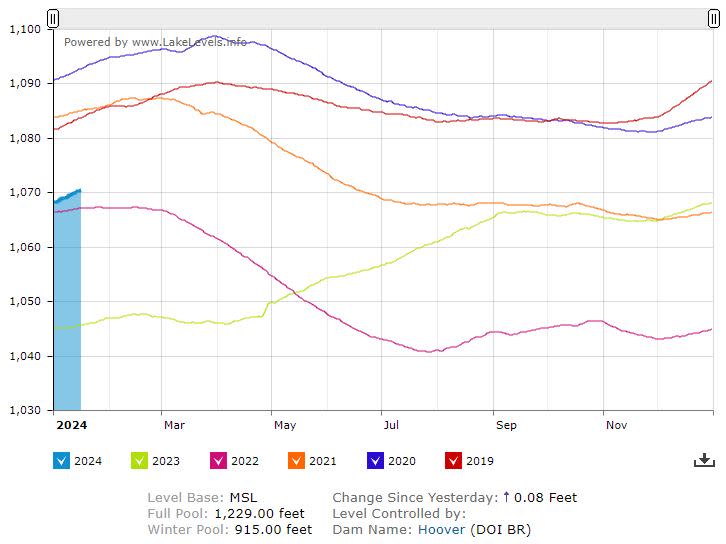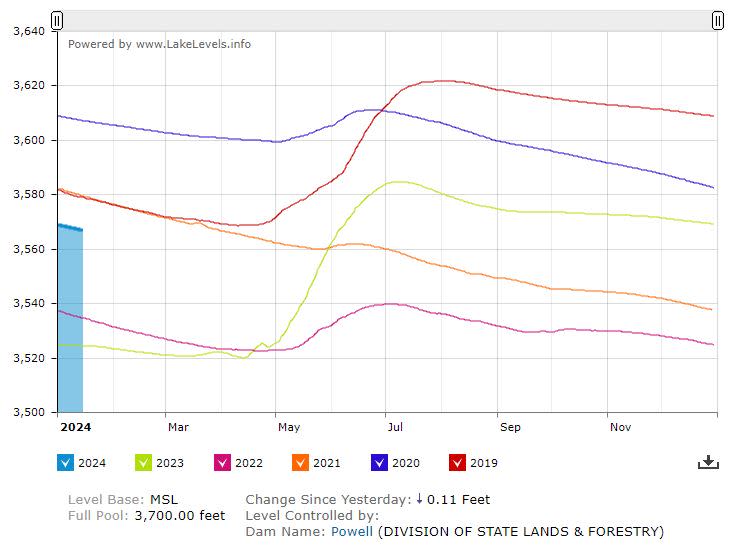Lake Mead level rising, but a big drop is coming, projections show
LAS VEGAS (KLAS) — Lake Mead is higher than it’s been since early summer of 2021, and the level is expected to rise another 3 feet before the end of February, according to projections released Tuesday by the U.S. Bureau of Reclamation.
But then the lake will drop steadily over 2024, ending the year 17 feet lower by the end of December. And in 2025, the “most probable” projection puts Lake Mead just a few feet above the lowest it has been since the lake was filled in the 1930s. That amounts to a 29-foot drop over the next two years.
Here’s a look at the current level at Lake Mead, the largest reservoir in the country.
Lake Mead:

On Tuesday, Lake Mead was at 1,070.31 feet. It is projected to rise to 1,073.32 feet by the end of February.
Projections contained in Reclamation’s 24-month study show the lake will drop to 1,056.19 feet by the end of December 2024. By the end of December 2025, Lake Mead will drop to 1,044.33 feet. On July 27, 2022, Lake Mead dropped to its lowest level since it was filled: 1,041.71 feet above sea level.
Over the past few months, the most probable projection has shown Lake Mead’s level growing slightly by the end of the summer of 2025. Since Reclamation’s November update, the September 2025 level has gone up by almost 2 1/2 feet.
Reclamation doesn’t just look at the “most probable” water levels. The agency, which is responsible for operating the dams along the Colorado River and delivering water to cities, counties, states and even tribal governments, also tracks “probable minimum” and “probable maximum.” Those levels establish the range of possible outcomes according to government data. By the end of 2025, the probable minimum would be about 5 feet lower than most probable, and the probable maximum could be more than 27 feet higher.

Tracking the “most probable” gives a good idea of what to expect, but even then, Lake Mead is only part of the story.
If Lake Mead is the biggest, Lake Powell is second on the list of the country’s largest reservoirs. And the reality is that water released from Lake Powell (through Glen Canyon Dam) feeds Lake Mead. An extremely wet winter in the Upper Colorado River Basin last year helped restore levels at both reservoirs over the past year, but Lake Mead is only 35% full and Lake Powell is at 36%.
Snowpack levels are only at 83% of normal so far this year. 8 News Now will have a full report on snowpack on Wednesday.
Projections for Lake Powell tell another big part of the story. Here’s a look at current levels:
Lake Powell:

According to Reclamation’s 24-month study, Lake Powell will rise from its December 2023 level of 3,568.97 to a December 2025 projection of 3,574.65 feet — an increase of more than 5 1/2 feet as Lake Mead is dropping a projected 29 feet.
Clearly, Reclamation has made raising Lake Powell’s level a priority.
What’s harder to gauge as the 24-Month Study evolves from month to month is the effect of recent conservation agreements and the impact of the weather on water consumption. Wet weather in California can reduce demand for Colorado River water, but how that translates for Lake Mead and Lake Powell is never spelled out in Reclamation’s reports.
Recent agreements with tribal governments and water agencies in California and Arizona have been detailed. The spell out payments from the U.S. government — some in the form of funding for water conservation projects — that commit unused water for storage in Lake Mead.
But the projections for Lake Mead either don’t reflect those agreements yet, or the government models show more extremely dry conditions ahead.
For the latest news, weather, sports, and streaming video, head to KLAS.

